MUSEUMS IN TOKYO
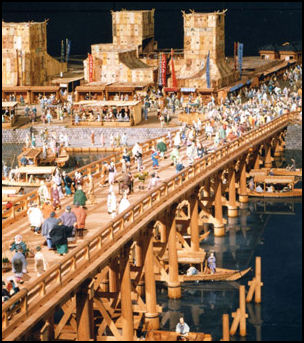
Edo-Tokyo Museum There are about 50 museums in the Tokyo area. Many museums specialize in one particular area. Admission prices vary. They are generally closed Monday (or the day after if it is a national holiday) and the New Year's holidays. They are generally open from around 9:00am or 10:00am to 5:00pm or 6:00pm. Enter at least 30 minutes before closing time. There are some museums in in the Imperial Palace area of central Tokyo but more interesting ones can be found in the Ueno, Roppongi and Odaiba areas. The National Museum of Modern Art (mostly Japanese modern art), the Craft Museum and the Science Foundation Museum (Ueno's National Science Museum is better) are located in Kitanomaru Park (part of the Imperial Palace). Websites: JNTO web magazine jw-webmagazine.com; Condé Nast Traveler cntraveler.com;Japan Guide japan-guide.com
Museum Pass: The Tokyo Museum-Grutto pass costs ¥2200, is valid for two months and offers free or discounted admission to 56 facilities, including the Tokyo National Museum, the Mori Art Museum, Ueno Zoological Gardens, and other museums, art galleries, aquariums zoos and facilities. Website: Museum site rekibun.or.jp
Museums in Ueno Park Tokyo National Museum, the National Museum of Western Art, the Tokyo Metropolitan Fine Art Gallery (with mostly temporary exhibits of contemporary Japanese art), the National Science Museum and Ueno Zoological Gardens are located in Ueno Park.
Museums in Roppongi: Roppongi is beginning to challenge Ueno Park as Tokyo’s museum hub. The New Suntory Museum of Art, with its fine collection of arts, and the 21_21 Design Site, a research museum inspired by Issey Miyake, opened in Roppongi in 2007 as part of the $3 billion Tokyo Midtown Project. The Mori art museum occupies the top six floors of Roppongi Hills and is regarded a center Tokyo contemporary art. The Okura Shukokan Museum, with a historical collection, and an annex for the Sen-oku Hakuko Kan museum are also in Roppongi Hills. Websites: Japan Guide japan-guide.com
See YOKOHAMA, SAITAMA AND CHIBA for museums like the Fujiko F. Fujio Museum (Doraemon Museum), Railway Museum, Hoki Museum, Cup-a-Noodle Museum and Others
Tokyo National Museum
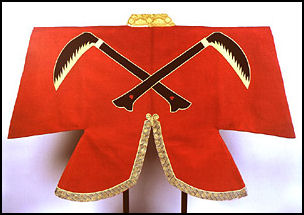
at the Tokyo National Museum Tokyo National Museum (Ueno Park, Ueno Station) is the oldest and largest museum in Japan and has one of the world's biggest collections of Japanese and Asian art, . The collection is so big that only a portion of the 117,000 items can be shown at one time. Particularly impressive are the displays of painted screens, calligraphy, swords and lacquerware. On the vast ground that surround the multiple-building museum are lawns and serene gardens. Many of the visitors to the museum come to see the first rate exhibitions rather than the permanent collection
The Gallery of Eastern Antiquities contains art and archeological objects from all over Asia. Among the treasures here are an A.D. 2nd century Buddha from Gandhara, Pakistan; a mummy in a coffin from ancient Egypt, a 13th century celadon glazed tea bowl and an 11th century paintings of red and white hibiscus flowers by the Chinese artist Li Di.
Buddhist sculptures and stone reliefs dating back to the 2nd and 3rd centuries feature works from Pakistan, Afghanistan, Cambodia, China, the Korean Peninsula and Japan. Two of the sculptures regarded as masterpieces are the Standing Bodhisattva (2nd-3rd century AD, Gandhara, Pakistan) and Standing Buddha (2nd-3rd century AD, Peshawar, Pakistan) — the former being a model for the pre-enlightenment prince Siddhartha and the latter for the post-enlightenment Buddha. There are also Chinese figurines and Gandharan reliefs depicting Siddhartha's birth (from below his mother Maya's arm) and others showing scenes from his life. Among the the Japanese sculptures listed as Important Cultural Properties are the Standing Buddha at Birth (Kamakura Period, 13th century) and the Buddha's Nirvana (Kamakura Period, 13th century) depicting the reclining Buddha entering into Nirvana at his passing.
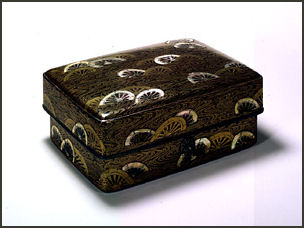
at the Tokyo National Museum The Hyokeikan houses Japanese archeological finds and items used by the Ainu. Here you can see 4000-year-old clay figures, examples of the world oldest pottery, an A.D. 4th century bronze mirror with dragons and bell-shaped Chinese bronzes dating to the 14th century B.C. In another area Japan’s most dog, Hachiko, stuffed and displayed, and a room of portraits of famous Japanese leaders and entertainment figures.
Among the treasures in the Japanese art section are detailed 13th century standing Basatsu bronzes; Katawaguruma cosmetics boxes made with maki-e lacquer with gold, mother of pearl inlay; 11th century calligraphy of the Lotus sutra; Noh costumes, valuable kimonos, gold painting by famous artists and a ukiyo-e collection with works by Utamaro and Hiroshige. As of March 2008, this section contained 87 items deemed National Treasures and 616 registered as Important Cultural properties.
The museum was renovated between July and September 2004. The displays were completely reorganized so that they made more sense. Now, not only is the art arranged chronologically it also grouped into themes within a particular period. The second floor of the museum is now devoted to the history of Japanese art with an aims of helping visitors understand and appreciate the art not just observe it, with special attention given to the tea ceremony, ukiyoe and customs of the Edo period. On the first floor objects are groups by art form, with area for paintings, lacquerware and gold and bronze Buddha statues. There are also displays of Ainu cultural and everyday items and photographs of the Okinawa-based Ryukyu Kingdom.
The renovated museum has more English signs and captions and computers where you looks stuff up and hands on exhibits where you can your hand at different art forms. Information areas are conveniently located and floor plan brochures are available in several languages. The museum also host a wide range of lectures and discussion and concerts and other events. Hours Open: 9:30 a.m.-5:00pm; open until 9:00pm on Fridays and Saturdays. Closed: Monday and the year end through New Year’s holiday. Getting There: 10-minute walk from JR or subway Ueno Station Website: Tokyo National Museum site tnm.go.jp
Gallery of Horyuji (part of the Tokyo National Museum) is dedicated to preservation of 319 delicate, 1,200-year-old works of art — mostly bronze Buddha and bodhisattva statues, nimbuses, reliefs, scrolls and masks — taken from Nara's Horyuji temple after it was damaged by fire in 1949. In the past the works were only displayed on Thursday unless the humidity level was too high and then they weren't shown at all. In 1999, a new facility was opened that allows the works to be shown every day.
The dramatic approach to The Gallery of Horyuji Treasures foreshadows the equally dramatic use of space and lighting that awaits inside the spacious foyer, halls, and galleries that give an otherworldly experience to visitors. Designed by Yoshio Taniguchi and opened in 1999, the museum houses over 300 valuable pieces dating from the 7th to the 8th century that were gifted from the Horyuji Temple in Nara to the imperial family in 1878, and then transferred to the museum after World War II. Boasting state-of-the-art conservation technology, the museum also has a digital archive featuring the entire collection. Contact: 13-9 Ueno Park, Taito-ku, Tokyo 110-8712 +81-3-5777-8600 Tokyo
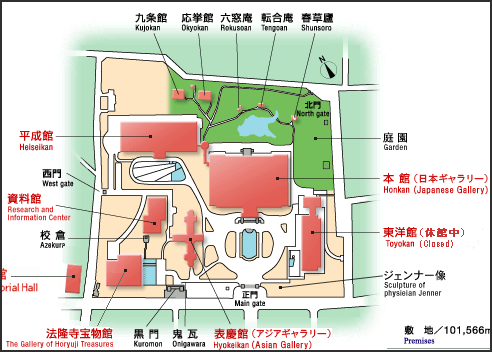
Tokyo National Museum map
National Museum of Western Art
National Museum of Western Art (Ueno Park) was designed by the famous Swiss architect Le Corbusier and holds an impressive collection of old and new Western art. Situated at the main entrance of Ueno Park, the National Museum of Western Art is a symbol of French-Japanese cultural relations. The museum exhibits works from the Matsukata Collection as well as works created from the Renaissance through the early 20th century.
The National Museum of Western Art (NMWA) contains works by Rodin, Renoir and Monet in a cement building designed by Le Corbusier. The museum was established to house paintings and other art seized by France under the 1951 San Francisco Peace Treaty and were returned to Japan on the condition a museum was built to house them. The main buildings was completed in 1959 and is the only work by Le Corbusier in Japan. Location: 7-7 Ueno-koen, Taito-ku, Tokyo 110-0007 +81-3-5777-8600 Hours Open: 9:30 a.m.-5:30pm/-8:00pm (Friday) Closed: Monday, December 28-January 1 and during changing exhibition. Getting There: on-minute walk from JR or subway Ueno Station.
In 2016, 17 works by Le Corbusier, including the National Museum of Western Art main building were designated a UNESCO World Heritage Site called " The Architectural Work of Le Corbusier, an Outstanding Contribution to the Modern Movement." According to UNESCO: “Chosen from the work of Le Corbusier, the 17 sites comprising this transnational serial property are spread over seven countries and are a testimonial to the invention of a new architectural language that made a break with the past. They were built over a period of a half-century, in the course of what Le Corbusier described as “patient research”. The Complexe du Capitole in Chandigarh (India), the National Museum of Western Art, Tokyo (Japan), the House of Dr Curutchet in La Plata (Argentina) and the Unité d’habitation in Marseille (France) reflect the solutions that the Modern Movement sought to apply during the 20th century to the challenges of inventing new architectural techniques to respond to the needs of society. These masterpieces of creative genius also attest to the internationalization of architectural practice across the planet. [Source: UNESCO]
”Chosen from the work of architect Le Corbusier that survives in eleven countries on four continents, the sites in seven countries on three continents, implemented over a period of half a century, for the first time in the history of architecture attest to the internationalization of architectural practice across the entire planet.
”The seventeen sites together represent an outstanding response to some of the fundamental issues of architecture and society in the 20th century. All were innovative in the way they reflect new concepts, all had a significant influence over wide geographical areas, and together they disseminated ideas of the Modern Movement throughout the world. Despite its diversity, the Modern Movement was a major and essential socio-cultural and historical entity of the 20th century, which has to a large degree remained the basis of the architectural culture of the 21st century. From the 1910s to the 1960s, the Modern Movement, in meeting the challenges of contemporary society, aimed to instigate a unique forum of ideas at a world level, invent a new architectural language, modernize architectural techniques and meet the social and human needs of modern man. The series provides an outstanding response to all these challenges.
”Some of the component sites immediately assumed an iconic status and had world-wide influence. These include the Villa Savoye, as an icon for the Modern Movement; Unité d’habitation in Marseille as a major prototype of a new housing model based on a balance between the individual and the collective....Other sites acted as catalysts for spreading ideas around their own regions, such as Maison Guiette, that spurred the development of the Modern Movement in Belgium and the Netherlands; the Maison du Docteur Curutchet that exerted a fundamental influence in South America; the Musée National des Beaux-Arts de l’Occident as the prototype of the globally transposable Museum of Unlimited Growth which cemented ideas of the Modern Movement in Japan; and the Capitol Complex that had a considerable influence across the Indian subcontinent, where it symbolized India’s accession to modernity.”
National Art Center Tokyo
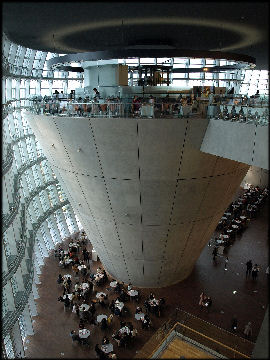
National Art Center Tokyo (Roppongi Hills) has Japan's largest exhibition space and serves as a venue for various art exhibitions. Opened in January 2007 and designed by the architect Kisho Kurokawa, it is a $300 million architectural marvel with lots of gallery space and a stunning glass facade, said to resemble a tsunami wave, augmented by beautifully-landscaped entrance. The only thing its lacks thus far are exhibits of art worthy to fill it.
The art center (known as NACT for short) contains 14,000 square meters of exhibition space: 10 exhibitor rooms, each 1,000 square meters in size, and two 2,000-square-meter special exhibition galleries. The rooms contain no pillars, giving the staff flexibility in how they want to set them up for displays. The museum will not have a permanent collection. Instead it will host high-profile temporary exhibitions and be a focal point for the art scene in Tokyo, Japan and the world. The National Art Center doesn’t have its own permanent collection, but is capable of organizing a wide variety of art exhibitions, in addition to artist associations and competition exhibitions unique to Japan. The building is the last museum designed by the architect, Kisho Kurokawa.
On his design Kurokawa told the Asahi Shimbun, “Architecture that creates ambiguity and a little bit of confusion makes people think, or makes them go into a maze. In the design for the NACT, I use several ambiguities. The first one is the ambiguity of interior and exterior. The second way is high-tech and primitive.” Among the center’s greatest delights are a bamboo garden located in an unexpected place and interior iron wood floor that continues outside the building. Among its high-tech features are cleaning robots and lights that brighten and dim when you walk by them. Two concrete tornados welcome visitors at the main door. Location: 7-22-2 Roppongi, Minato-ku, Tokyo 106-8558 +81-3-5777-8600 Hours Open: 10:00 a.m.-6:00pm Closed: Tue. and the year end through New Year’s holiday. Getting There: 1-minute walk from Nogisaka Station or 5-minute walk from Roppongi Station Websites: National Art Center Tokyo site nact.jp
History -Related Museums
Edo-Tokyo Museum (Sumida-ku in Ryogoku) is a modern silvery-steel building that contains models of Edo (Tokyo) at various periods of its history and a complete set of Hiroshige's “100 Famous Views of Edo” , a model of the shogun’s palace and an exhibit of Meiji-era consumer goods. Edo-Tokyo Museum enable visitors to learn the history, life styles and culture of Tokyo, focusing mainly on those in the Edo period. Hours Open: 9:30 a.m.-5:30pm/-7:30pm (Saturday) Closed: Monday and the year end through New Year’s holiday. Getting There: 3-minute walk from JR Ryogoku Station. Website: Official Museum site edo-tokyo-museum.or.jp
Edo-Tokyo Open Air Architectural Museum is a the branch of the Edo-Tokyo Museum, preserves restored farm houses, residences, public bath house, Japanese-style pub, soy sauce store and other buildings of periods from the 19th to early 20th centuries. Hours Open: 9:30 a.m.-4:30pm (October-March) /-5:30pm (April-September) Closed: Monday and December 28-January 4. Getting There: 5 minutes from JR Musashi-Koganei Station by bus.
Ancient Egyptian Museum (8th floor of the Mezon Shibuya Building, near Tower Records, five minute walk from Shibuya Station) contains as you might expect a reasonable display of ancient Egyptian artifacts and then goes a step further by trying to replicate what it is like to explore the inside of an ancient tomb in attempt to bring to life the period in the 1920s when many of the great discoveries of Egyptology were made. Admission is ¥1,500.
Great Kanto Memorial Museum (in Yokoamicho Park, 2-3-25 Yokoami, Sumida City) and the Tokyo Metropolitan Memorial Hall commemorate of those who lost their lives during the 1923 Tokyo earthquake and fire and the U.S. fire-bombing air raids of World War II. Ryotaro Maeda wrote in the Yomiuri Shimbun: “Grim relics on display include a half-melted teapot in which someone’s hidden nest egg of coins has been fused into a solid mass, and a box of sweets that were turned to charcoal by the intense heat. According to a pamphlet given to visitors at the park’s gloomy, mausoleumlike museum (free admission), the site in 1923 was a vacant lot on which thousands of people gathered in hope of escaping massive post-earthquake fires, only to die when flames consumed the crowd itself.”[Source: Ryotaro Maeda, Yomiuri Shimbun, January 4, 2012]
Ghibli Museum
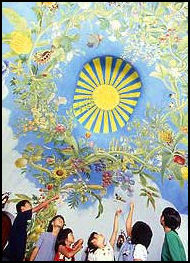
Ghibli Museum (Mitaka Station on the JR Chuo train line) is the brainchild of Hayao Miyazaki, the Japanese animator that created “Princess Mononoke” and “My Neighbor Totoro “ and won an Academy Award for “Spirited Away” . Opened in October 2001 and built at a cost of $42 million, it is designed by Miyazaki himself and named after Miyazaki’s studio. It attracted more than one million visitors and is best described as a hands-on art museum-playground for children.
Ghibli Museum is a unique space aimed at evoking memories of childhood and inspiring fantasy. The museum building is a maze of stairways, passages and rooms that calls to mind some of the mysterious sets from Miyazaki’s films. Inside are displays of works by Miyazaki and members his Ghibli studio staff, reproductions of animated characters and rooms and studio intended to convey the work that goes into making animated films. Sometimes his films are shown here and nowhere else. Several Miyazaki short anime films such as “Mr. Dough and the Egg Princess “ debuted at the Ghibli Museum’s 80-seat Saturn theater. Reservations are required for these.
Margaret Talbot wrote the in The New Yorker, “From the outside, the museum resembles an oversized adobe house, with slightly melted edges; its exterior walls are painted in saltwater-taffy shades of pink, green and yellow. Inside, the museum looks like a child’s fantasy of Old Europe submitted to a rigorous Arts and Crafts sensibility...stained-glass windows cast candy colored light on white-washed walls; a spiral stairway climbs...to a rooftop garden of wild grasses, over which a hammered-metal robot soldier stands guard. In the central hall, beneath a high ceiling, a web of balconies and bridges suggests a dream vison of a 19th century factory.”
Among its notable features are reproductions of the cat-shaped bus from “My Neighbor Totoro” large enough to climb on; and exhibits like “Where a Film Begins” , depicting a room where a boy dreams up an idea for a film. The restaurant features home cooking rather than restaurant food.
Hours Open: The museum is open everyday except Tuesday from 10:00am to 6:00pm. It is also closed during the New Year’s holiday and for periodic maintenance. Admission: Admission is ¥1,000 for adults, ¥700 for middle and high school students, ¥400 for primary school students and ¥100 for pre school children and free for children under four. You must book a reserved ticket which specifies the appointed date of the reservation in advance. For ticket information, please check the official website. Website: ghibli-museum.jp/en/ticket-information Getting There: 15-minute walk or 5 minutes by bus from Mitaka Sta. on JR Chuo Line (20 minutes from Shinjuku Station). Tour: JTB (travel agency) hosts Ghibli Museum Afternoon Tour with an English-speaking guide to the museum and its vicinity every Monday, Wednesday and Friday Fee: Adults ¥6,000, Child ¥4,700 Minimum number of participants: Website: jtb-sunrisetours.jp Websites: Ghibli Museum site ghibli-museum.jp ; Photos and Background Information tautoz.com ; Japan Guide japan-guide.com, Tel: 0570-055-777 (Japanese only).
Image Sources: 1) Edo-Tokyo Museum 2) 3) 4) Tokyo National Museum 5) 16) Ray Kinnane 6) 7) Ghibli Museum 8) Tepco Museum 9) National Science Museum 10 Sumo Museum 11) 12) 13) 14) 15) Twin isles
Text Sources: JNTO (Japan National Tourist Organization), Japan.org, Japan News, Japan Times, Yomiuri Shimbun, UNESCO, Lonely Planet guides, New York Times, Washington Post, Los Angeles Times, National Geographic, The New Yorker, Bloomberg, Reuters, Associated Press, AFP, Compton's Encyclopedia and various books and other publications.
Updated in July 2020
